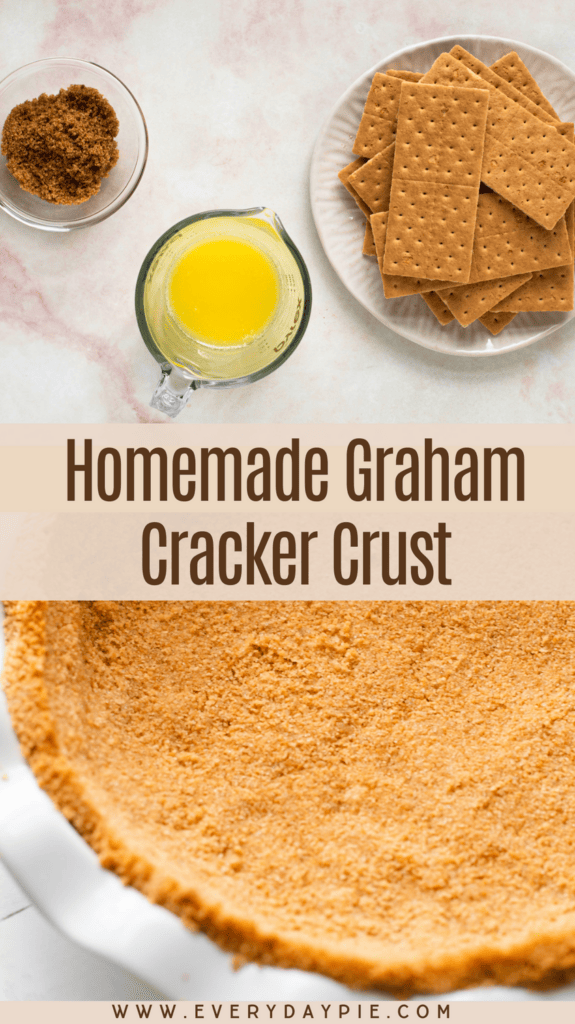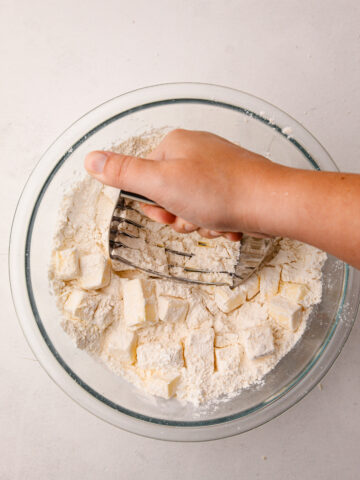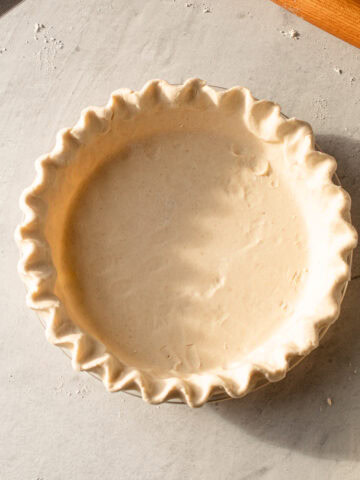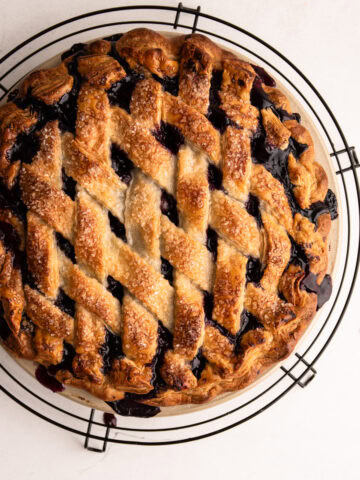This simple Graham Cracker Crust is a classic recipe, perfect for so many different types of pies! It requires just four ingredients that are pressed into the pie plate, and I'm showing you the easiest way to do it.

Want to save this recipe?
Enter your email & I'll send it to your inbox. Plus, get weekly updates from me!
Sometimes, you just need a super easy, no-brainer pie crust, and this Homemade Graham Cracker Crust recipe checks all those boxes! Using just a few simple ingredients, this versatile crust adds a delightful sweetness and crunch that is perfect for cheesecakes (or cheesecake pies like this Blueberry Cream Cheese Pie), tarts (like Honeynut Tart), and no-bake pies (like this Banana Cream Pie).
If you are new to making this style of pie crust, check out this guide on How to Make Crumb Crusts to read more about them and the alternatives to using graham crackers as the base.
Ingredient Needed
Here is an overview of the ingredients needed for this recipe. The full recipe is listed below in greater detail.

- graham crackers (you can use traditional or gluten-free)
- sugar (you can use granulated sugar or brown sugar, with the biggest difference just being the flavor)
- unsalted butter
- salt (just a pinch will do the trick to help amplify the flavor of the pie crust)
Making the Crumbs
You can actually find store-bought graham cracker crumbs! So if you find them an want to use them, by all means. But most people already have some graham crackers at home, and it's just as easy to grind them up fresh yourself. Using a food processor or blender is the easiest method. However, some people find cleaning up a food processor to be a chore for such a little task. Smashing the crackers by hand is also an option. The simplest method is to put the crackers in a plastic bag, press out the air, seal it, and crush the contents with a rolling pin or meat pounder. However, some drawbacks to this method: it requires manual effort, can produce an uneven crumb texture, and might be time-consuming based on the amount you need to crush.
Whichever way you make them, aim for crumbs that are about the size of grains of sand, with as much evenness as possible. Some variation in texture is okay, but keep in mind that uneven pieces can result in a less-than-sturdy crust.

Troubleshooting
The amount of butter needed can vary due to differences in moisture and fat in various graham cracker brands. Start by adding a smaller amount of butter to the crumbs, adjusting as needed. It's useful to keep extra crumbs on hand to balance the texture—aim for a consistency similar to wet sand: when squeezed, it should hold together and compact easily without feeling sticky or greasy.
If the crumb mixture is extremely dry, add more melted butter–one tablespoon at a time–to the crumbs until they are evenly moistened. Alternatively, if your mixture is too wet and hard to work with, add more graham cracker crumbs until it easily clumps together.

How to Form the Crust
I used to avoid graham cracker crusts because I found them messy and fussy to press into the pan. When I ran my pie business, I never offered a pie with a graham cracker crust. That all changed when I discovered a more efficient way to form them: start by creating the edges of the crust first, then firmly press the crumb mixture into the bottom of the plate.
Here is a visual overview:

Step 1: Pour the crumb mixture into the pie plate.

Step 2: Gather the crumb mixture loosely around and up the sides of the plate, then form the top edges of the crust and neaten them by pressing them together with two fingers.

Step 3: Next, use your thumb to pack down the sides of the crumb crust against the pie plate in an even layer. As you do this, move the excess crumb mixture toward the center of the pie plate.

Step 4: Continue packing the crumbs from the outer edges towards the middle until you have a single layer. Then with your fingers, a spatula, or the bottom of a measuring cup, pack down the crumbs until everything is tight and even.
To Freeze or To Bake
Once it's shaped, the graham cracker crust can be par-baked or frozen before filling. Freezing solidifies the butter but doesn’t melt the sugar all the way to create a very strong bond, making it best for chilled pies. Par-baking it creates a crispier, more stable, more flavorful crust by melting the sugar and adding a toasty element. I prefer par-baking, but sometimes turning on the oven for just 10 minutes isn't practical. Choose the method that suits your needs best (and pie)!

Types of Pie to Use with a Graham Cracker Crust
A graham cracker crust can be used for creamy or chocolatey no-bake or icebox-style pies. However, it isn't as sturdy as regular pie pastry, so it isn't ideal for full-on fruit pies. Thin custards, like in a Classic Custard Pie, can also be tricky to pair with a crumb crust. Pouring a thin filling can cause the crumbs to break apart and rise to the top. While I've had some success (like in this Strawberry Cream Pie), it requires extra care, such as making a thick, well-packed crumb mixture.
Here are some pie ideas and suggestions that go well with a graham cracker crumb crust:
- Some chocolate pies (like this Brownie Pecan Pie or Malted Milk Chocolate Pie)
- No-bake cheesecake style pies (such as this Cherry Cream Cheese Pie or No-Bake Cannoli Pie )
- Thicker custard / baked cheesecake pies (such as this Pistachio and Mascarpone Pie or Roasted Plum Pie)
- Pudding pies, aka cream pies (like this Butterscotch Cream Pie or Pistachio Cream Pie)
- Ice cream pies (like this Baked Alaska Pie)
More Easy Pie Crusts
I am so honored when you make a recipe from my site! If you make this Graham Cracker Crust, please leave a star ⭐️⭐️⭐️⭐️⭐️ rating with your experience! If you have any questions about this recipe, feel free to comment here, and tag me on instagram!
Full Recipe
Graham Cracker Crumb Crust
This simple Graham Cracker Crust is a classic recipe, perfect for so many different types of pies! It has just four ingredients that are pressed into the pie plate, and I'm showing you the easiest way to do it.
- Prep Time: 00:05
- Cook Time: 00:10
- Total Time: 15 minutes
- Yield: 1-(9") pie crust
- Category: Pie Crust
Ingredients
- 8 tablespoons unsalted butter, melted, more as needed
- 2 cups (8 ounces) graham cracker crumbs (from about 14 sheets), more as needed
- ¼ cup (50 grams) granulated sugar or brown sugar
- ¼ teaspoon coarse kosher salt
Instructions
- In a bowl, mix together the graham cracker crumbs, melted butter, sugar, and salt. The mixture should be damp, like wet sand, and will hold together when squeezed. If it is too dry, add more melted butter, a tablespoon at a time. If it’s too wet, add more graham cracker crumbs, a tablespoon at a time, until it’s the correct consistency.
- Pour the crumbs into a 9-inch pie plate and press them up the sides to form the edges first. Once the edges are formed, work the crumbs down to evenly distribute them into the bottom of the pie plate. Then, pack them down into an even layer using a flat-bottomed cup or measuring cup.
- The crumb crust can be baked in a 350ºF preheated oven for 10 minutes for a more toasted flavor, or this step can be skipped. Place the (cooled if baked) pie crust in the freezer to firm up.
Notes
New to making crumb crusts? Check out this comprehensive guide, How to Make a Crumb Crust, for more information.
This recipe was tested using Diamond Crystal coarse kosher salt. If you use Morton's kosher salt or fine salt, decrease the volume by half. See this Salt Guide for more information about how salt affects your cooking and baking.
Graham crackers different from brand to brand and may have a drier texture than others. Adjust the amount of butter or crumbs needed to get the correct consistency for shaping the crumb crust, adding more butter or more crumbs as needed.
Some of the links on this page may be affiliate links. Everyday Pie is a participant in the Amazon Associates Program. As an Amazon Associate I earn from qualifying purchases, at no extra cost to you.









Ben Wordell
This page definitely has all the information I wanted concerning this subject and didn’t know who to ask.
CATHY GALATI
I have trouble when I put my ricotta filling I bake it when cut my crust breaks away from filling what am I DOING WRONG?
Kelli Avila
Hi Cathy. What ricotta filling are you using? I'm not sure you are necessarily doing anything wrong.
Nick kudd
Did you try substituting cream instead of the butter
Kat M
I made this last Thanksgiving for a chocolate pudding pie and used it recently for the base of a Key Lime Pie recipe! So delicious with the brown sugar. I even went one step further and browned the butter to give it an extra oomph and it made the most delicious crust. My go-to for graham cracker crusts!
Kelli Avila
Genius! I love the idea of browning the butter! So glad you liked it!
Horacio
Can I leave the crums on top of the cheesecake flan whlie baking so I can turn it upside down.
Kelli Avila
I'm not sure that would work. If you give it a try, let us know how it goes!